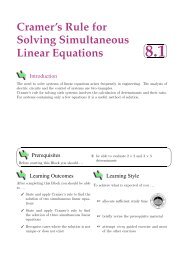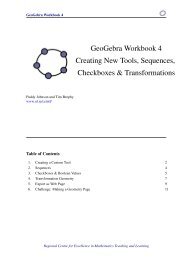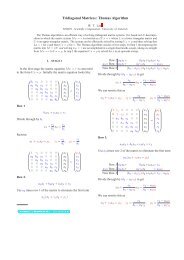Student Notes To Accompany MS4214: STATISTICAL INFERENCE
Student Notes To Accompany MS4214: STATISTICAL INFERENCE
Student Notes To Accompany MS4214: STATISTICAL INFERENCE
You also want an ePaper? Increase the reach of your titles
YUMPU automatically turns print PDFs into web optimized ePapers that Google loves.
Now consider the random experiment which consists of picking 3 people at random<br />
from the 1997 electoral register for Limerick. The outcome of such an experiment will<br />
be a collection of 3 human beings and the set S consists of all subsets of 3 human<br />
beings which may be formed from the set of all human beings whose names are on the<br />
register. We can clearly envisage an infinite sequence of independent repetitions of such<br />
an experiment. Consider the random vector X = (X1, X2, X3) where for i = 1, 2, 3,<br />
Xi = 0 if the ith person chosen is a male and Xi = 1 if the ith person chosen is a<br />
female. When we say that X1, X2, X3 are independent and identically distributed or IID<br />
with P (Xi = 1) = θ we are taken to mean that in an infinite sequence of independent<br />
repetitions of the experiment the proportion of outcomes which produce, for instance,<br />
a value of X = (1, 1, 0) is given by θ 2 (1 − θ).<br />
Suppose that the value of θ is unknown and we propose to estimate it by the<br />
estimator ˆ θ whose value is given by the proportion of females in the sample of size 3.<br />
Since ˆ θ depends on the value of X we sometimes write ˆ θ(X) to emphasise this fact.<br />
We can work out the probability distribution of ˆ θ as follows :<br />
X P (X = x) ˆ θ(x)<br />
(0, 0, 0) (1 − θ) 3 0<br />
(0, 0, 1) θ(1 − θ) 2 1/3<br />
(0, 1, 0) θ(1 − θ) 2 1/3<br />
(1, 0, 0) θ(1 − θ) 2 1/3<br />
(0, 1, 1) θ 2 (1 − θ) 2/3<br />
(1, 0, 1) θ 2 (1 − θ) 2/3<br />
(1, 1, 0) θ 2 (1 − θ) 2/3<br />
(1, 1, 1) θ 3 1<br />
Thus P ( ˆ θ = 0) = (1 − θ) 3 , P ( ˆ θ = 1/3) = 3θ(1 − θ) 2 , P ( ˆ θ = 2/3) = 3θ 2 (1 − θ) and<br />
P ( ˆ θ = 1) = θ 3 . We now ask whether ˆ θ is a good estimator of θ? Clearly if θ = 0 we<br />
have that P ( ˆ θ = θ) = P ( ˆ θ = 0) = 1 which is good. Likewise if θ = 1 we also have that<br />
P ( ˆ θ = θ) = P ( ˆ θ = 1) = 1. If θ = 1/3 then P ( ˆ θ = θ) = P ( ˆ θ = 1/3) = 3(1/3)(1−1/3) 2 =<br />
4/9. Likewise if θ = 2/3 we have that P ( ˆ θ = θ) = P ( ˆ θ = 2/3) = 3(2/3) 2 (1−2/3) = 4/9.<br />
However if the value of θ lies outside the set {0, 1/3, 2/3, 1} we have that P ( ˆ θ = θ) = 0.<br />
Since ˆ θ is a random variable we might try to calculate its expected value E( ˆ θ) i.e.<br />
the average value we would get if we carried out an infinite number of independent<br />
repetitions of the experiment. We have that<br />
E( ˆ θ) = 0P ( ˆ θ = 0) + (1/3)P ( ˆ θ = 1/3) + (2/3)P ( ˆ θ = 2/3) + 1P ( ˆ θ = 1) ,<br />
= 0(1 − θ) 3 + (1/3)3θ(1 − θ) 2 + (2/3)3θ 2 (1 − θ) + 1θ 3 ,<br />
= θ.<br />
9






